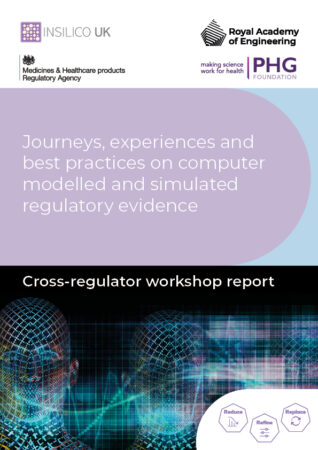Journeys, experiences and best practices on computer modelled and simulated regulatory evidence is the result of a recent collaboration from InSilicoUK, MHRA, the Royal Academy of Engineering and the PHG Foundation.
In the era of AI and digital health innovation, the importance and value of computer modelled and simulated evidence for clinical trials is increasing, yet uncertainty remains on its regulatory acceptability. PHG Foundation co-convened a cross-regulator workshop to find out if increased regulatory acceptance of computer modelled and simulated evidence can be achieved.
Key findings include:
- Consensus statement: Regulators could go a long way in easing stakeholder uncertainty with a consensus statement, signalling their openness towards CM&S generated evidence. The statement could also indicate regulator support for undertaking health economic analysis to highlight their value and encourage further industry adoption.
- Industrial, academic, and wider stakeholders’ uncertainty could be ameliorated by a high-level consensus statement by regulators signalling their openness towards CM&S generated evidence and its associated methods and undertaking health economic analysis in the medium-to-longer term to highlight their value and encourage further industry adoption.
- Public engagement: A top priority is exploring public acceptance and trust within regulatory pathways. Increased public engagement initiatives such as Citizen’s Jury events are needed to understand the public’s concerns, to ensure transparency and to earn trust.
- Development of generalisable principles: The development of good simulation practices and standards that support sound regulatory evidence with an emphasis on CM&S methods at both generalised and sector-specific levels are needed, and initial steps have been made by looking at adapting HM Treasury’s Aqua Book to keep pace with ever-changing technology in the AI and digital innovation space.
- International standard-setting and harmonisation: A need to look at developing mock or pre-submission processes for CM&S methods and at harmonising international standards in the medium to long term.
- Encouragement of future cross-sector discussions: There is a good, cross-sector appetite to continue collaborative efforts to maintain momentum generated by the July workshop and to use such dialogues to continue to learn from each other’s experiences, including with the addition of further stakeholders in future collaborative discussions.
Share this content

